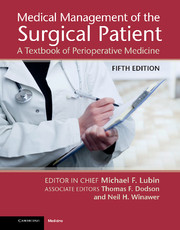Book contents
- Frontmatter
- Dedication
- Contents
- List of Contributors
- Preface
- Introduction
- Part 1 Perioperative Care of the Surgical Patient
- Section 1 General
- Section 2 Cardiology
- Section 3 Hypertension
- Section 4 Pulmonary
- Chapter 12 Perioperative pulmonary risk evaluation and management for non-cardiothoracic surgery
- Chapter 13 Perioperative management of the asthma patient
- Chapter 14 Acute lung injury and the acute respiratory distress syndrome
- Chapter 15 Postoperative pulmonary complications
- Section 5 Gastroenterology
- Section 6 Hematology
- Section 7 Infectious disease
- Section 8 Renal disease
- Section 9 Endocrinology
- Section 10 Rheumatology
- Section 11 Neurology
- Section 12 Surgery in the Elderly
- Section 13 Obesity
- Section 14 Transplantation
- Section 15 Psychiatric Disorders
- Section 16 Peripartum Patients
- Part 2 Surgical Procedures and their Complications
- Index
- References
Chapter 12 - Perioperative pulmonary risk evaluation and management for non-cardiothoracic surgery
from Section 4 - Pulmonary
Published online by Cambridge University Press: 05 September 2013
- Frontmatter
- Dedication
- Contents
- List of Contributors
- Preface
- Introduction
- Part 1 Perioperative Care of the Surgical Patient
- Section 1 General
- Section 2 Cardiology
- Section 3 Hypertension
- Section 4 Pulmonary
- Chapter 12 Perioperative pulmonary risk evaluation and management for non-cardiothoracic surgery
- Chapter 13 Perioperative management of the asthma patient
- Chapter 14 Acute lung injury and the acute respiratory distress syndrome
- Chapter 15 Postoperative pulmonary complications
- Section 5 Gastroenterology
- Section 6 Hematology
- Section 7 Infectious disease
- Section 8 Renal disease
- Section 9 Endocrinology
- Section 10 Rheumatology
- Section 11 Neurology
- Section 12 Surgery in the Elderly
- Section 13 Obesity
- Section 14 Transplantation
- Section 15 Psychiatric Disorders
- Section 16 Peripartum Patients
- Part 2 Surgical Procedures and their Complications
- Index
- References
Summary
Introduction
Postoperative pulmonary complications (PPCs) are as common as cardiac complications following non-cardiothoracic surgery and carry significant morbidity and mortality [1]. The incidence of PPCs was higher than cardiac complications (2.7% vs 2.5%) in the cohort of non-cardiac surgical patients used to validate the Revised Cardiac Risk Index [2]. An earlier study of patients undergoing abdominal surgery revealed not only similar results but also longer hospital stays [3]. More recently, Lawrence et al. in a large retrospective cohort study of patients undergoing hip repair showed that serious pulmonary and cardiac complications have similar incidence and significant impact on mortality and length of stay [4].
Postoperative pulmonary complications are a marker of poor prognosis. In patients with or without respiratory failure following vascular and general surgical procedures, mortality at 30 days in the respiratory failure group was 26.5% compared with 1.4% in those without it [5]. Similarly, a prospective study of patients age ≥ 70 years examined predictors of mortality up to 3 years following non-cardiac surgery. Postoperative pulmonary complications were independent predictors of decreased long-term survival [6]. These findings confirm the clinical importance of PPCs.
- Type
- Chapter
- Information
- Medical Management of the Surgical PatientA Textbook of Perioperative Medicine, pp. 133 - 146Publisher: Cambridge University PressPrint publication year: 2013

